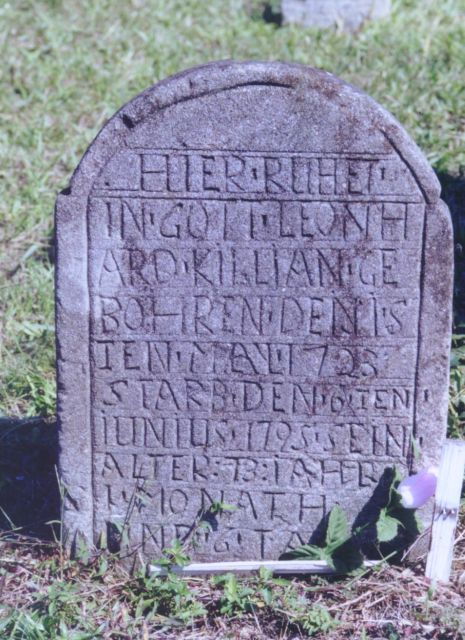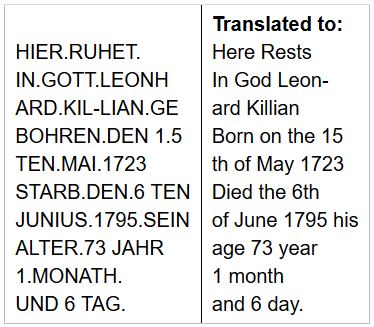Leonard Killian

 New Info: March 26, 2008 By researcher William McCreight,
a North Carolina native now living in Germany. On 30 April 1724
the son of Andreas Kilian, the younger, and Margaretha Fischer
Kilian was baptized in Erzberg and named Leonhardt after the
child's godfather, Leonhardt Steyern, a blacksmith from
Wildenholz. Wildenholz is one mile south of Steinbach. Andreas
Kilian, the younger, was described as a weaver. This baptismal
record is consistent with the date of Leonhardt's birth taken
from his grave mark.
New Info: March 26, 2008 By researcher William McCreight,
a North Carolina native now living in Germany. On 30 April 1724
the son of Andreas Kilian, the younger, and Margaretha Fischer
Kilian was baptized in Erzberg and named Leonhardt after the
child's godfather, Leonhardt Steyern, a blacksmith from
Wildenholz. Wildenholz is one mile south of Steinbach. Andreas
Kilian, the younger, was described as a weaver. This baptismal
record is consistent with the date of Leonhardt's birth taken
from his grave mark.
Leonard Killian is the second child, and first son, of Andreas Killian (1702 - 1788) the pioneer who came to America from Germany in 1732. Although in Germany Andreas' name was Kilian (with one "L") he used the two "L" form after his arrival in America. His descendants use mostly the two "L" form of the name as he did. However, some of Leonard's descendants use the name Killion. (Note the use of "O" in the name rather than the more common "A". Bill Hinds, of Florida has made a long term study of Leonard's descendants and has a web site with many thousands of his descendants. In like manner Ed Killian, of Mississippi has studied the descendants of Andreas' son, George and has a web site with that information. My own web site includes all of Andreas' descendants, but does not attempt to include the massive information included in the sites mentioned above. Leonard Killian inadvertently confused the subsequent generations by marrying a girl whose name was Mary Margaret Killen. For decades it was assumed that Killen was just another bad spelling of her married name. Not the case, her maiden name was Killen. His life is also very interesting because his tombstone is in the German language and gives the dates of his birth and death as well as his age in years, months and days. The dates and age are not consistent. The material below sheds some light on this curious anomaly. Leonard tombstone is in Old St. Paul's Church Cemetery which is located about one mile northwest of Newton, NC. The tombstone is in the German language. This might suggest that German was spoken in his home, or that Germany was still thought of as the "home" country. Since Leonard was nine years old when he arrived in America this may seem a little surprising. However, in both PA and NC where he lived there were many Germans.
A brief history of St. Paul's Church begins: "A great emigration of German colonists mostly from PA began settling in the Piedmont area of NC during the first half of the eighteenth century. These people were of the Lutheran and Reformed faiths. As a result of living and working together, members of the two denominations agreed to build common houses of worship. Old St. Paul's Church in Catawba County just northwest of Newton was organized about 1759. St. Paul's was the first church established in the State west of the Catawba River. The Church was originally known as The Dutch Meeting House', but became known as The South Fork Church' about the beginning of the nineteenth century. It came to be called by its present name, Old St. Paul's' sometime afterwards. The cemetery has reached extensive proportions. Many graves date back to the 1700's. Most tombstones are still legible, but others obviously older were either never inscribed or since eroded by time and the elements. Among the markers chiseled in German is included one dedicated to the memory of Abraham Mauser who died in 1702". Leonard's tombstone is #341 in the cemetery and according to the book reads as follows on a line for line basis:
A native German who examined this said the use of the periods was old and unusual but that there was no doubt it still meant the birth date as the 15th. It has also been suggested that it would have been more proper to add an "E" at the end of the last word of the last line and at the end of the last word of the third from the last line, to make the words plural. Also the "U" in the second word of the first line might more properly have been "š". The reason for the hyphen in "Killian" was not understood. I wonder if the hyphen in the Killian could be some sort of way of saying that the name was originally with a single "L", The "GE" after Killian is part of the word on the next line, i.e. words end with a period.
With the dates given one could calculate Leonard as into his 73rd year by only 23 days (counting both the 15th and 6th). Perhaps it was custom to count all of the month of birth as one month and then the six days of June. During Leonard's life there was a calendar reform in 1752 which caused the skipping of eleven days. At this time it would be speculation as to the birth date being given by the old calendar or the new. Probably the old calendar would be my guess. But I have understood that some historical dates have been converted to their equivalent on the new calendar so that by the old calendar George Washington was born 11 Feb 1732, but this is converted to 22 Feb 1732 for the new calendar. Part of the world had been using the new calendar (our present calendar, the Gregorian calendar) for many years when England adopted it. In any event no matter how I try to adjust for the calendar change I can not get Leonard 1 month and 6 days into his 73rd year by any means other than that already suggested. If the suggestion is not correct it means that there is a clear error on the tombstone and we can only speculate concerning where the error lies without other data. Tombstone are NOT generally accepted as accurate and reliable data sources. Also the tombstone may have been so old when the text was copied that there was an error in reading one or more of the numbers. I have seen the tombstone and believe an experienced person should have been able to read it accurately.
In March 1992 a Jerry Waldrop called me about another matter. He collects data about tombstones and has published a few books about tombstones in cemeteries in and around Catawba Co., NC. He particularly works on family cemeteries. I asked him about the dates on Leonard's tombstone. He said that the stone mason often added the age in years, months and days and that he often did it from poorly constructed tables. He said the dates of birth and death are more likely right than the age in years months and days, and that tombstone data is not usually accepted as authentic.
I have also thought that tombstones may include age in years, months and days if the person's life spanned the calendar change.
By: George W. Killian
For more information on Leonard Killian and descendents:
See Bill Hinds website at
http://wc.rootsweb.ancestry.com/cgi-bin/igm.cgi?op=GET&db=killion&id=I3234